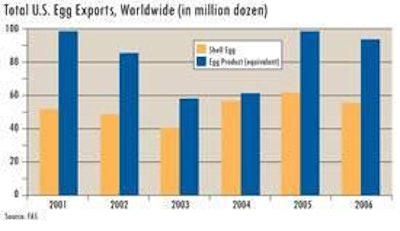
"If the first two months are any indication, it should be a banner year," says James Sumner, president of the USA Poultry & Egg Export Council, Stone Mountain, Ga.
For the first two months of the year, shell egg exports due to surprising strength of orders from mostly Europe through the United States Egg Marketers (USEM) were up 147% from the same period in 2006 on a volume basis and a 134% increase on a value basis. That works out to 14.7 million dozen eggs exported in the first two months of 2007 compared to 6 million dozen a year ago.
"While we're very pleased, I'm not sure shell egg exports can be maintained at that level for the remainder of the year, however," Sumner says.
For 2006, exports of eggs and egg products totalled $181 million. Total exports increased 12.5% from 2005 to 2006, with last year's exports 58.8% above 2002 levels. As the charts show, exports of egg products have increased substantially relative to shell egg exports in recent years.
More Deals May Be in Works
Other shell egg deals could be forthcoming this year, says Larry Seger, USEM chairman of the board. One reason why, he says, is that with grain and oilseed prices so high, other countries may be concluding that it makes more economic sense to import eggs and other animal proteins than corn and soybeans.
Increases on the egg products side were also impressive in January and February, though not quite so staggering. Exports on a value basis were up 37%, to $26 million, U.S. Department of Agriculture data show. Because liquid, frozen and dried eggs are all combined, looking at volumes gives an inaccurate read of the data, Sumner says.
It's impressive that processed exports were up, he says, with Japan, the U.S. largest processed egg market, down slightly. Helping to offset that were exports to Mexico, which were up 83%, and a 322% increase to the Middle East.
One reason Sumner gives for the increases "is that food service is realizing that a lot of labor can be saved by buying processed eggs." As a result of this and high grain prices, which favor U.S. egg producers, he sees the 3% total of U.S. egg production that is exported "going up."
Europe Cage-Free, Aids U.S. Exports
Another reason for the trend of increased exports of U.S. egg products to Europe is the movement to cage-free production there is limiting production, says Dave Cisneros, vice president of Sparboe Cos., Litchfield, Minn. "And Asia offers good prospects," he says. Cisneros agrees that high grain prices favor the United States. "South America has the advantage on soybean meal, but egg production is more corn-based," and the United States is self-sufficient in corn, he says.
The trend in egg product exports, Cisneros says, is going to be more value-added egg products. And while demand is not there now, he sees omelettes and egg patties offering export potential.
Bret Jenkin, food service business manager for Primera Foods, Cameron, Wis., says that the big increase in shell egg exports, which could be processed by other countries, could hurt exports of processed egg products this year. On the positive side for the United States, he says, is that the country does not have avian influenza, and has a reputation for product safety and qualityalthough it's nothing that can be taken for granted.
Jenkin adds that U.S. processors "have to be better, because there's new competition out there on frozen whole eggs and powdersfrom China, India, and Australia."


















